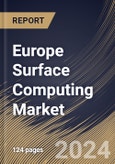Surface computing has found a natural fit in education, transforming traditional classrooms into interactive learning environments. Interactive whiteboards, touch-sensitive tables, and collaborative learning applications enhance student engagement, foster creativity, and encourage collaborative problem-solving. The technology's intuitive nature also supports students with diverse learning needs. Interactive whiteboards have become a cornerstone of modern educational technology. These large touch-sensitive displays replace traditional blackboards or whiteboards, allowing educators to deliver dynamic and interactive lessons. Teachers can use touch or stylus inputs to annotate content, draw diagrams, and interact with multimedia resources in real time, creating a more engaging and visually stimulating learning environment.
Furthermore, in manufacturing and design, it aids in collaborative product development and prototyping. Designers can manipulate digital models with natural gestures, fostering creativity and innovation. Interactive surfaces in manufacturing environments streamline processes, from assembly line management to quality control. The intuitive nature of surface computing is particularly advantageous during the prototyping phase. Digital prototypes enable designers to rapidly iterate through design variations, make real-time adjustments, and observe the effects of modifications. This accelerates the design iteration process, allowing for rapid prototyping and refinement of product designs based on immediate feedback.
The automotive industry in Germany has been at the forefront of developing and implementing advanced driver assistance systems (ADAS). As per the data from the Government of the United Kingdom released in 2023, in December 2021, the government provided £1 billion in support for UK businesses most affected by the Omicron variant, including one-time grants of up to £6,000 per premise for hospitality and leisure businesses and more than £100 million discretionary funding through local authorities. Thus, rising digitalization in the automotive sector and the growing hospitality sector in Europe will drive the demand in the region.
The Germany market dominated the Europe Surface Computing Market, By Country in 2022, and would continue to be a dominant market till 2030; thereby, achieving a market value of $22,547.6 million by 2030. The UK market is exhibiting a CAGR of 30.8% during (2023 - 2030). Additionally, The France market would experience a CAGR of 33% during (2023 - 2030).
Based on Component, the market is segmented into Hardware, and Software. Based on Display Type, the market is segmented into Flat Display, and Curved Display. Based on Vertical, the market is segmented into Healthcare, BFSI, Hospitality, Retail, Automotive, and Others. Based on countries, the market is segmented into Germany, UK, France, Russia, Spain, Italy, and Rest of Europe.
List of Key Companies Profiled
- Microsoft Corporation
- Sony Corporation
- Dell Technologies, Inc.
- Samsung Electronics Co., Ltd. (Samsung Group)
- Apple Inc.
- LG Electronics Inc.
- Leyard Optoelectronic Co. (Planar Systems, Inc.)
- Lenovo Group Limited
- HP Inc.
- Fujitsu Limited
Market Report Segmentation
By Component- Hardware
- Software
- Flat Display
- Curved Display
- Healthcare
- BFSI
- Hospitality
- Retail
- Automotive
- Others
- Germany
- UK
- France
- Russia
- Spain
- Italy
- Rest of Europe
Table of Contents
Companies Mentioned
- Microsoft Corporation
- Sony Corporation
- Dell Technologies, Inc.
- Samsung Electronics Co., Ltd. (Samsung Group)
- Apple Inc.
- LG Electronics Inc.
- Leyard Optoelectronic Co. (Planar Systems, Inc.)
- Lenovo Group Limited
- HP Inc.
- Fujitsu Limited
Methodology

LOADING...








